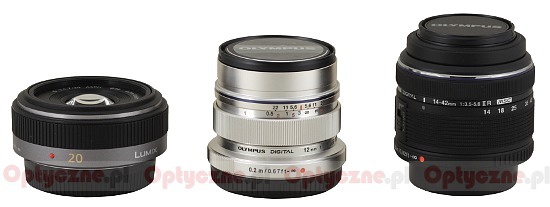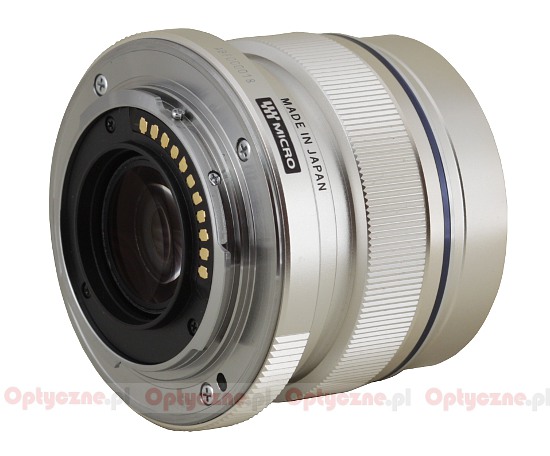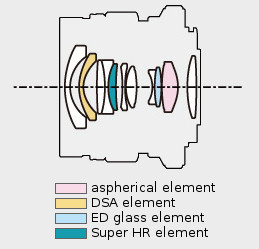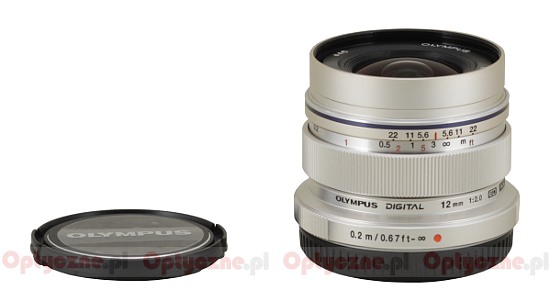Olympus M.Zuiko Digital 12 mm f/2.0 ED
3. Build quality
As you can see the diagonal angles of view of Sony and Samsung „pancakes” are very much alike. Despite being a bit slower, these lenses provide the same depth of field as the Olympus because of a larger detector. Of course their slower aperture forces to use longer exposure times. Compared to the Olympus there are also smaller and it is one of their strong points – the ED2/12 is definitely not a “pancake”. We must emphasize the fact, though, that it is not a big lens either and it fits Micro 4/3 bodies in a perfect way.
In the photo below the tested lens is positioned next to the Panasonic 1.7/20 “pancake” and the Olympus 14-42 mm kit lens.
Please Support UsIf you enjoy our reviews and articles, and you want us to continue our work please, support our website by donating through PayPal. The funds are going to be used for paying our editorial team, renting servers, and equipping our testing studio; only that way we will be able to continue providing you interesting content for free. |
- - - - - - - - - - - - - - - - - - - - - - - - - - - - - - - - - - - - - - - - - - - - - - - -
 |
The Olympus M.Zuiko Digital 12 mm f/2.0 ED is very solidly build. Its casing and mount are made of sheer, shiny, silver metal. Inside the mount we can find contacts and a rear element, 19 mm in diameter. Its size is significantly bigger than that of typical system “pancakes” which gives a hope the image quality on the edges of the field of view will be high. The rear element is immobile so the focusing is performed by the shift of optical elements inside the system.
 |
Passing to the casing itself we find a wider ring on it, ribbed on its left and on its right – it is supposed to make the grip firmer and the attaching the lens to the body easier. On that immobile ring you can also see some info about the lens’s focal lengths’ range and its serial number. The next narrow and smooth ring features the name and parameters of the lens and also a boastful inscription: “Made in Japan”
Next we meet a manual focus ring. It is ribbed and 1 cm wide; its work is smooth and well-damped. Running through the whole scale takes a turn of about 110 degrees. What’s important, the ring changes its position. If it is pressed towards the front element it works in the autofocus mode (but after setting the AF-MF mode at the body level it allows you to change focus as well); if you shift it towards the body it works in the manual mode, revealing a distance scale, expressed in meters and feet.
Above the manual focus ring there is a depth of field scale showing markings at f/22, f/11 and f/5.6 aperture. Above that scale there is a smooth piece of casing, 11 mm wide, and the lens ends immediately afterwards.
At the front you find a non-rotating filter thread, 46 mm in diameter, inside which there is a fragment of casing with the name and the parameters of the lens; it surrounds a front, immobile element with a diameter of 27 mm.
The inner construction of the lens consists of 11 elements positioned in 8 groups. It is obvious the producer didn’t stint on special elements - we get one low-dispersion ED glass element, one with the high refraction index (Super HR), one aspherical element and one dual aspherical element (DSA - Dual Super Aspherical). Inside you can also find an aperture with seven diaphragm blades which can be closed down to f/22. Apart from that it is worth mentioning that the producer boasts of using new ZERO coatings (ZUIKO Extra-low Reflection Optical) which, compared to conventional coatings, are supposed to reduce unwanted light reflections to a half.

Unfortunately, despite the steep price of the lens, we get only caps in the box. A hood or a case we must buy on our own.
 |






